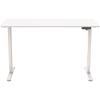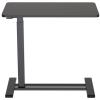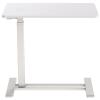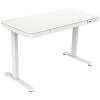Standing desks have become a staple in modern workspaces, and for good reason. Whether you're working from home or in an office, switching between sitting and standing throughout the day can have a powerful impact on your health, productivity, and overall well-being. They’re also perfect for when you come back from lunch feeling a little too bloated and are worried about snoozing away if you sit down!
Today, we’re looking at six science-backed benefits of standing desks and how to make the most of them.
But first, what are standing desks, and how do they work?
Standing desks, also known as sit-stand desks or height-adjustable desks, are workstations designed to allow users to alternate between sitting and standing throughout the day. Unlike traditional desks, standing desks can be raised or lowered to suit your posture and working style, helping you stay active while you work.
There are several types of standing desks:
- Manual standing desks use hand cranks or levers to adjust height.
- Electric standing desks feature motorised controls for smooth transitions.
- Converter desks sit atop existing desks and can be lifted to standing height.
The core idea behind standing desks is simple: reduce the amount of time spent sitting, which has been linked to a range of health issues, including back pain, poor posture, and cardiovascular risks. By standing for portions of your workday, you engage your muscles, improve circulation, and encourage better posture - all without sacrificing productivity.
Modern standing desks often come with programmable presets, cable management systems, and ergonomic accessories like anti-fatigue mats and monitor arms. These features make it easier to create a workspace that supports both comfort and movement.

Whether you're working from home or in a corporate office, standing desks offer a flexible and health-conscious alternative to traditional setups. And as more research highlights the risks of prolonged sitting, standing desks are becoming a key part of workplace wellness strategies around the world, including here in New Zealand.
1. May Lower Risk of Weight Gain and Obesity
Standing desks can play a meaningful role in weight management and reducing the risk of obesity. Research published in the Journal of Physical Activity and Health found that a person weighing around 65 kg could burn an additional 54 calories per day simply by standing instead of sitting. Over the course of a year, that adds up to nearly 20,000 calories, equivalent to about 2.5 kg of body fat.
Another study led by Dr. John Buckley at the University of Chester revealed that standing for three hours each workday is metabolically comparable to running over 10 marathons annually, without the sweat or training regimen. While standing alone won’t replace regular exercise, it’s a simple and sustainable way to increase daily energy expenditure. Standing desks are most effective when combined with other healthy habits like regular movement, stretching, and a balanced diet. So yes, raising your desk might help, but don’t ditch the gym just yet!
2. May Lower Risk of Heart Disease
The link between prolonged sitting and heart disease is well-established, and standing desks can help break that cycle. Research shows that adults who sit for more than two hours at a time have a significantly higher risk of developing cardiovascular issues, including chest pain, high blood pressure, and even heart attacks.
Why? Because extended periods of sitting reduce the body’s ability to effectively process fats and sugars. This can lead to a build-up of glucose and lipids in the bloodstream, contributing to obesity, insulin resistance, and cholesterol imbalances, all of which are major risk factors for heart disease.
In fact, some studies suggest that the risk of cardiovascular disease may increase by as much as 147% due to prolonged sedentary behaviour.
3. May Lower Blood Sugar Levels
After a meal, it’s normal for blood sugar levels to rise, but staying seated for hours afterwards can amplify that spike and, over time, increase the risk of developing Type 2 diabetes. Fortunately, standing or engaging in light movement after eating can help regulate blood sugar more effectively.
In a small study involving 10 office workers, those who stood for 180 minutes after lunch experienced a 43% smaller blood sugar spike compared to those who remained seated for the same duration. Interestingly, both groups took a similar number of steps, suggesting that the benefit came specifically from standing, not from additional physical activity.
Takeaway: Incorporating standing periods into your post-lunch routine can be a simple yet powerful way to support metabolic health, especially when paired with a balanced diet and regular movement.


4. Reduce Back Pain and Improve Posture
Back pain is one of the most common complaints among office workers, especially those who spend long hours seated. Fortunately, height-adjustable standing desks offer a practical solution. A study by the Centers for Disease Control and Prevention (CDC) found that using a sit-stand desk reduced upper back and neck pain by 54% after just four weeks. Interestingly, when the desks were removed, some of those improvements reversed within two weeks, highlighting the importance of consistent use.
Standing desks promote a more upright posture, helping to reduce the strain on your neck and spine caused by slouching. They also encourage subtle engagement of your core muscles, which supports better spinal alignment and overall posture.
Pro Tip: To get the most benefit, alternate between sitting and standing throughout the day. Make sure your desk and monitor are set at ergonomic heights to avoid new sources of strain.
5. Improve Mood and Energy Levels
Standing desks don’t just benefit your physical health; they can also enhance your mental well-being. Standing encourages better blood circulation, which increases oxygen flow to the brain and muscles. This can lead to improved alertness, reduced fatigue, and a noticeable lift in mood.
A seven-week study published in the International Journal of Environmental Research and Public Health found that participants who used standing desks reported less stress and fatigue compared to those who sat all day. Impressively, 87% of standing desk users said they felt more energetic and invigorated throughout the workday.
Why it matters: Incorporating standing into your daily routine can help counteract the sluggishness that often comes with prolonged sitting, making you feel more focused, motivated, and ready to tackle your tasks.
6. Boosts Productivity
Beyond the health perks, standing desks may also enhance your productivity. As we mentioned earlier, standing promotes better blood flow and oxygen delivery to the brain, which can improve concentration, alertness, and cognitive function, key ingredients for staying focused and efficient.
A six-month study published in IIE Transactions on Occupational Ergonomics and Human Factors tracked call centre employees and found that those using standing desks were 45% more productive on a daily basis compared to their seated peers. The researchers suggested that increased physical activity led to heightened mental engagement, which translated into better performance.
Shop Standing Desks now!
There are a host of ergonomic work solutions that can positively impact our health and productivity, including height adjustable desks, monitor mounts, standing workstations and much more. We talk about these in our article '5 Ways to Improve Your Workstation Ergonomics'. In this article, we include standing desk recommendations and more, so be sure to check that out if you need some suggestions! Otherwise, head over to our furniture department to check out our entire range of Height Adjustable Desks.
Frequently Asked Questions
How long should you stand at a standing desk?
It's generally recommended to start with 15-20 minute periods of standing and gradually increase them as your strength and stamina improve. The goal should be to sit less and move more throughout the day. Experts propose a sit-stand ratio of 2:1 to 3:1; for example, for every 2-3 hours you sit, you should stand for 1 hour. However, individual comfort levels should dictate the exact durations. Always ensure you maintain good posture while standing to maximise the benefits. Notice your legs getting tired and your posture reflecting that? Switch back to sitting.
Is standing for eight hours bad?
Yes, it is not recommended for you to stand for long periods, as this can have its own issues. These can include fatigue, leg cramps, and backaches. Moreover, prolonged and frequent standing (without movement) can cause blood to pool in the legs and feet. Over time, this may lead to conditions such as varicose veins and inflammation, amongst other things. Additionally, the heart has to work against gravity to keep blood flowing up from the toes and legs, which can have an impact on the cardiovascular system. The ideal approach is a balance of sitting, standing, and moving throughout the day.
Are standing desks better for your back?
Yes, a standing desk can be better for your back if used correctly. When you stand up, your spine maintains its natural S-shaped curvature, reducing the risk of back pain. Standing encourages better posture by aligning your back, neck, and shoulders, which decreases the strain often associated with prolonged sitting. However, it's important to alternate standing with sitting and moving about to prevent fatigue and ensure maximum benefits. Remember that proper ergonomics while standing is also crucial, such as proper desk and monitor height, to prevent hunching or craning your neck.
Is it better to work standing or sitting?
Neither standing nor sitting all day is ideal. The best approach is a combination of sitting, standing, and moving throughout the day. Too much sitting can lead to obesity and related health problems, as well as back and neck pain. On the other hand, prolonged standing can result in muscle fatigue and discomfort. Alternating between sitting and standing work, incorporating short breaks to move or stretch, is often the most beneficial and ergonomically sound approach towards work.













1 comment
CoryO78
Thank You! So much for a great blog and best of luck for the future
Read more